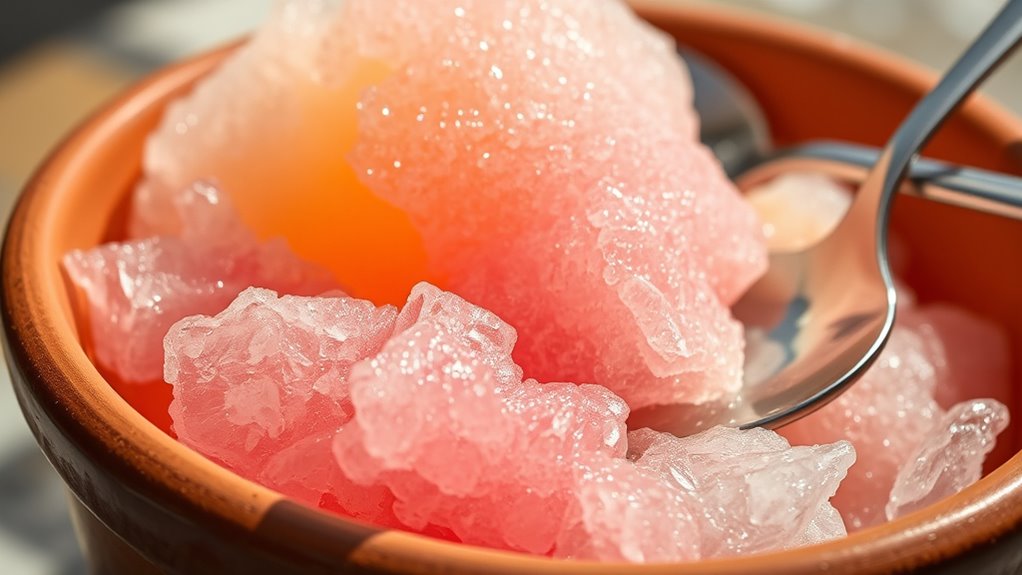Sicilian granita and sorbetto are deeply connected, both highlighting the island’s vibrant flavors and rich traditions. Granita offers a snow-like, textured experience with bold, invigorating fruit and herb blends, while sorbetto provides a smooth, silky consistency emphasizing seasonal fruits. Both treats reflect Sicily’s agricultural bounty and centuries of culinary history. Exploring their unique characteristics reveals the cultural pride behind each flavor. Keep exploring to uncover more about how these dessert traditions continue to shape Sicilian heritage.
Key Takeaways
- Both granita and sorbetto originate from Sicily’s rich culinary traditions, showcasing local fruits and ingredients.
- Granita has a granular, snow-like texture, while sorbetto offers a smooth, silky consistency, reflecting regional preferences.
- Flavors like lemon, almond, and pistachio are common in both, emphasizing Sicily’s agricultural bounty.
- Each treats’ preparation methods highlight centuries of cultural exchange and craftsmanship in Sicilian dessert-making.
- Both symbolize Sicily’s vibrant heritage, connecting locals and visitors through shared culinary history.

When it comes to flavor variations, you’ll find a dazzling array in Sicily’s local markets and cafes. Traditional flavors like lemon, almond, and pistachio are staples, highlighting the island’s abundant ingredients. Lemon granita, with its sharp, invigorating taste, is almost synonymous with Sicilian summers, while almond-flavored versions add a nutty sweetness that balances the heat perfectly. You’ll also discover unique regional twists, such as orange, watermelon, or even mint. Sorbetto offers similar diversity, often featuring seasonal fruits like strawberries or cherries, providing a smooth and intensely flavorful experience. What makes these treats enthralling is not just their invigorating qualities but also their versatility—each vendor takes pride in creating their signature flavor variations. Some combine fruits with herbs or spices, adding layers of complexity. Whether you prefer the granular, snow-like texture of granita or the silky, smooth consistency of sorbetto, you’re experiencing centuries of culinary tradition. These flavors reflect Sicily’s rich agricultural bounty and its history of cultural exchanges, making each spoonful a taste of the island’s vibrant heritage. So next time you savor a cold, fruity delight under the Sicilian sun, remember you’re enjoying a dessert with deep roots and a wide spectrum of flavors shaped by generations.
Frequently Asked Questions
What Are the Main Differences Between Granita and Sorbetto?
You’ll notice that granita has a coarser, more crystalline texture compared to sorbetto, which is smoother and creamier. When it melts, granita tends to do so slowly, maintaining its icy structure longer, while sorbetto melts quickly due to its softer consistency. These differences come from their preparation methods, with granita being more like shaved ice and sorbetto blending fruit puree and sugar for a velvety finish.
Which Ingredients Are Traditionally Used in Sicilian Granita?
You’d think Sicilian granita needs a fancy recipe, but it’s simple—just traditional ingredients like fresh fruit, sugar, and often lemon or almond essence. Regional variations spice things up with pistachios or coffee. Ironically, it’s these humble, local ingredients that make Sicily’s granita so unique and invigorating, showcasing the island’s rich flavors. So, don’t overlook the classics; they’re what truly define this icy delight.
How Is the Texture of Authentic Granita Achieved?
To achieve the authentic granita’s smooth yet icy texture, you focus on texture refinement through careful freezing techniques. You regularly scrape and stir the mixture as it freezes, breaking up ice crystals and creating a fine, crystalline structure. This process guarantees a balance between a slushy consistency and a refined, velvety mouthfeel, giving you that perfect, invigorating bite characteristic of true Sicilian granita.
Can Granita Be Made Vegan or Dairy-Free?
Imagine you’re in a vintage ice cream parlor—yes, even in the 21st century! You can totally make granita vegan or dairy-free by using plant-based milk like almond, coconut, or oat milk. Swap traditional dairy with these vegan substitutes, and add fresh fruit or juice for flavor. With dairy-free options, you get a revitalizing treat that’s just as delicious, and you don’t have to compromise on your dietary choices.
What Are Some Popular Flavor Combinations in Sicily?
You’ll find popular flavor combinations in Sicily often showcase regional variations and seasonal fruits. Classic choices include invigorating lemon and almond, vibrant watermelon and mint, or tangy blood orange and tangerine. During different times of the year, you might enjoy flavors like strawberry in spring or fig in late summer. These combinations highlight Sicily’s rich agricultural heritage and adapt beautifully to seasonal produce, making each granita uniquely flavorful.
Conclusion
So, next time you indulge in a invigorating frozen treat, remember Sicily’s rich tradition behind granita and sorbetto. You might think they’re just summer snacks, but they’re full of history and culture. Don’t let the differences fool you—both offer a perfect escape from the heat. Whether you prefer the icy texture of granita or the smoothness of sorbetto, embracing their connection makes every bite a taste of Sicily’s vibrant heritage.










